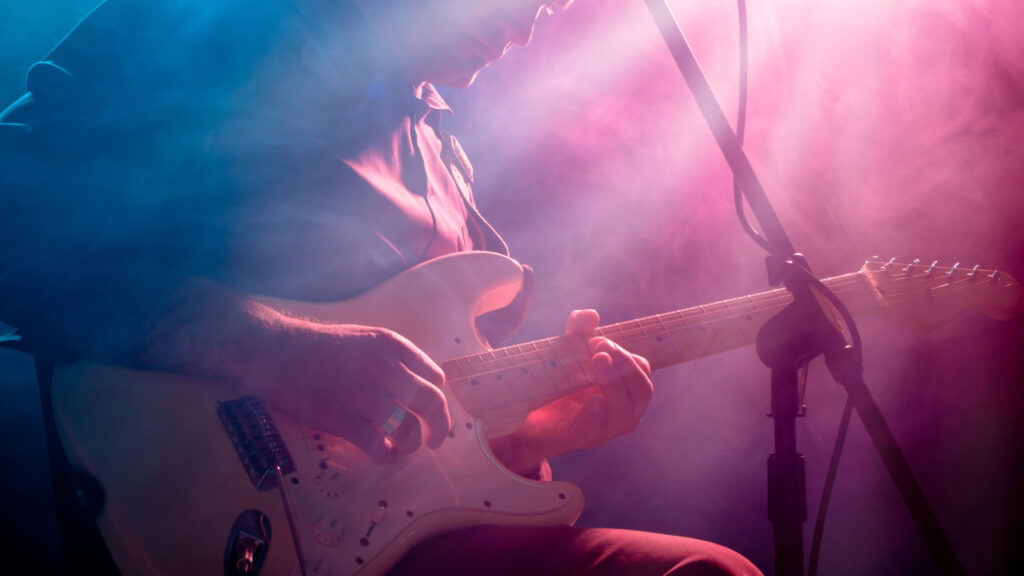During an audiologist’s career they may come across a few musicians who seek them out for answers about their ears and hearing health. For some audiologists, the task of thoroughly assessing a musician’s hearing and answering their questions may be a daunting task. Musicians have finely tuned ears and have superior auditory memory compared to non-musicians (Cohen, Evans, Horowitz, and Wolfe, 2011). These enhanced abilities and extensive knowledge of sound can lead to detailed questions about the testing, results, and proposed treatment that the audiologist is presenting. Audiologists need to be prepared to discuss these topics in depth.
Additionally, musicians can be frequently exposed to high levels of noise, which put them at greater risk for noise-induced hearing loss and tinnitus. Musicians may seek preventative advice and treatment including musicians ear plugs (MEPs) and in-ear monitors (IEMs), or seek out diagnosis and treatment when they suspect damage may have occurred to their auditory system. It is our job as audiologists to have thorough knowledge of how to test and treat musicians at every stage, so we can help the musicians keep doing what they do best: creating and performing music.
Diagnostic Hearing Testing for Musicians
There are additional diagnostic tests to add to an audiologist’s test battery when completing a hearing evaluation on a musician. An audiologist’s primary concern may be noise-induced hearing loss, which often appears in the extended high frequencies first. A standard audiological hearing evaluation tests pure tone frequencies from 250 to 8000 Hz. In addition to completing standard pure tone audiometry, completing extended high-frequency pure tone testing out 20,000 Hz if the audiometer is capable, will provide essential information about their complete frequency sensitivity and if/where noise is starting to damage the musician’s hearing.
Otoacoustic emissions (OAEs) testing is another useful evaluation which may detect noise-induced hearing loss early. Musicians may also seek help and information regarding tinnitus, or ringing/buzzing in their ears. Having the ability to pitch and loudness match their tinnitus may be valuable information to the musician.
Diagnostic testing recommended for musicians:
- Extended high-frequency audiometry
- Otoacoustic emissions
- Tinnitus pitch matching
Treatment: Hearing Technology and Programming
After the comprehensive hearing evaluation, the audiologist may determine that the appropriate treatment for the noise-induced hearing loss is amplification, or hearing aid technology. Musicians tend to have strong preferences for how they like things to sound, and have a superior auditory memory, so fitting them with amplification can be an involved task (Cohen, Evans, Horowitz, and Wolfe, 2011). Often musicians will prefer the amplified sound to be as natural as possible.
A specific music program can be set in hearing instruments so that the musician can switch between programs when in different listening environments. Some features of modern hearing instruments, such as adaptive compression and feedback cancellation may sound like distortion to the musician. While these features are often needed to achieve prescriptive targets and for general comfort, it is recommended to deactivate, or greatly reduce, these features in a music program. Creating a music program in the hearing instruments that is separate from the general speech programs allows for the audiologist to program these modern features when the musician is using the devices to understand speech, while allowing the freedom of not using the digital processing for the music program, to keep it as natural as possible.
When fitting a musician with amplification, real-ear measurement (REM) will be the audiologist’s best friend. Not only is REM a helpful and necessary tool for fitting hearing aids, it can also be a great way for the audiologist to inform the muscian on what the hearing devices are doing for them. During the hearing aid fitting appointment, it is also a good idea to have the musician play their instrument, or sing, while the audiologist is running REM to give live feedback on how the hearing devices are amplifying the music.
Additional considerations for fitting hearing aids for musicians:
- Linear fitting (commonly)
- Separate Music Program
- REM with instrument
Preventative Treatment: Hearing Protection Devices for Musicians
Hearing protection should be discussed with all musicians coming in to see an audiologist for evaluation/consult regarding their hearing healthcare. If the diagnostic testing reveals that the musician has normal hearing, or no treatable hearing loss, the audiologist should move the discussion to review appropriate hearing protection. Commonly, musicians will use filtered ear plugs or in-ear monitors while performing to protect their ears from loud sounds. Both of these types of hearing protection come in custom and non-custom options. Non-custom options offer a quick, low-cost solution, yet may not fit all ears; whereas custom earplugs and monitors are made specifically for an individual ear, and require earmold impressions taken by the audiologist. Having knowledge of earplug and in-ear monitor labs will be essential to providing the appropriate recommendation for hearing protection. Hearing protection is essential for musicians whether they currently have hearing loss, or normal hearing, because hearing protection can help prevent further damage to the auditory system from loud noise.
Working with musicians can be a challenging and very rewarding process. Having the proper tools, like an extended high- frequency audiometer, real ear measurement and otoacoustic emission equipment, allows for a more thorough assessment and to better help the musician meet their hearing and hearing protection goals. Ultimately, the goal of the audiologist is to assist the musician in continuing to do what they love — making music – while offering the best treatment plan for continued hearing health.
Citations
Cohen MA, Evans KK, Horowitz TS, Wolfe JM. Auditory and visual memory in musicians and nonmusicians. Psychon Bull Rev. 2011 Jun;18(3):586-91. doi: 10.3758/s13423-011-0074-0. PMID: 21374094; PMCID: PMC3967744.

